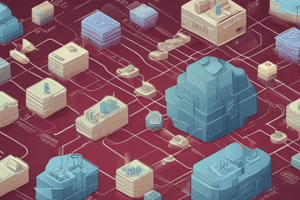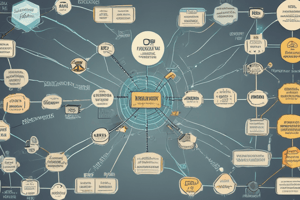Podcast
Questions and Answers
در چه زمینهای LANها نسبت به WANها عملکرد بهتری دارند؟
در چه زمینهای LANها نسبت به WANها عملکرد بهتری دارند؟
- پشتیبانی از ارتباطات بیسیم
- استفاده از امکانات بیشتر
- مدیریت سادهتر
- فرصت دسترسی سریعتر (correct)
چه تکنولوژیهایی برای ارتباط در LANها استفاده میشود؟
چه تکنولوژیهایی برای ارتباط در LANها استفاده میشود؟
- اترنت و سیگنالهای بیسیم (correct)
- پهنای باند بالا و تاخیر پایین
- امکانات بیشتر و مدیریت پیچیده
- خطوط اجاره شده از مخابرات
به چه عواملی عملکرد WANها بستگی دارد؟
به چه عواملی عملکرد WANها بستگی دارد؟
- فاصله و تجارت الکترونیک
- اتصالات VPN و شبکههای تلفن همراه
- سرعت و کیفیت مسیر (correct)
- فناوری و اجاره خطوط
چه جنبهای از ارتباطات LAN و WAN در تعامل با یکدیگر تأثیر مستقیم دارد؟
چه جنبهای از ارتباطات LAN و WAN در تعامل با یکدیگر تأثیر مستقیم دارد؟
چه عاملی WAN و LAN را از یکدیگر تفاوت محسوس میکند؟
چه عاملی WAN و LAN را از یکدیگر تفاوت محسوس میکند؟
Flashcards are hidden until you start studying
Study Notes
Understanding Networking Fundamentals: TCP/IP, LAN, and WAN
At its core, networking enables communication between devices, either within one location or across entire continents. To fully grasp this intricate field, let's dive into three fundamental concepts: TCP/IP, Local Area Network (LAN), and Wide Area Network (WAN)—the foundations upon which modern digital interactions rest.
TCP/IP (Transmission Control Protocol / Internet Protocol)
TCP/IP is a set of protocols responsible for moving data from a source device to its destination over a network. It establishes reliable connections among computers, allowing them to send messages back and forth while ensuring packets aren't lost during transmission and arrive at their destinations intact. This collection of standards has become synonymous with the internet itself, enabling seamless worldwide connectivity via various networks.
Key points:
- Establishes reliable communications between devices across local and wide area networks.
- Enables seamless international connectivity through standardized protocols.
- Comprises two main protocol layers: Transmission Control Protocol (TCP) for error control and Internet Protocol (IP) for addressing and routing.
Local Area Network (LAN)
A LAN is a group of interconnected computing devices confined to a limited geographical area such as a single building or campus. These systems facilitate efficient data exchange via a shared medium like Ethernet cables, wireless signals, or fiber optic cabling. LANs promote high bandwidth utilization, fast access times, and simplified management when compared to larger, more complex WAN environments.
Key Points:
- Concentrates computing resources within a small area.
- Utilizes wired or wireless technologies for communication.
- Typically supports higher speeds and lower latency due to proximity.
Wide Area Network (WAN)
In contrast to LANs, WANs span much wider distances, often crossing cities, states, countries, or even oceans. They rely on leased telecommunication lines and internet services for connecting disparate entities, enabling global collaboration despite vast physical separation. Common examples include the public internet, private corporate VPN connections, and mobile phone carrier networks.
Key Points:
- Provides connectivity beyond smaller, local areas.
- Involves multiple service providers for link establishment.
- Supports cross-continental communication with varying performance depending on distance, route quality, and traffic conditions.
While these three foundational elements may seem straightforward individually, understanding how they interact and complement each other provides the framework required for navigating today’s dynamic and ever-evolving digital landscape.
Studying That Suits You
Use AI to generate personalized quizzes and flashcards to suit your learning preferences.




